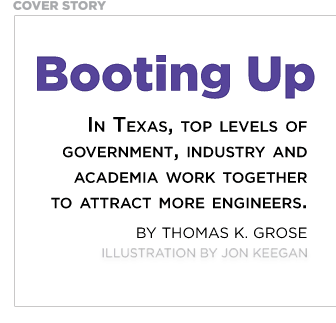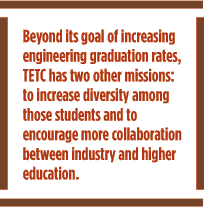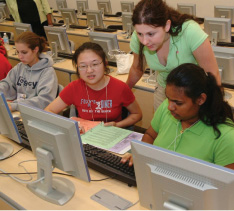Booting Up

As a freshman electrical engineering student at the University of Texas-Pan American in 2002, Andres Lugo struggled. UT Pan Am is a commuter school with a large Hispanic population in Texas’ Rio Grande Valley, and most students work off-campus jobs. Lugo was no exception. But the 20 hours a week he worked at Ticketmaster greatly interfered with his studies. Then he joined a unique program at UT Pan Am that gives students part-time jobs in the electrical engineering department to keep them on campus and focused on the demanding curriculum. Lugo’s grades improved. In his senior year, the faculty named him “Outstanding Student of the Year.” He’s now working for Raytheon and starting graduate school at the University of Texas at Dallas. The jobs program, he says, was key to his success. “I was able to keep school as my top priority,” Lugo explains. Moreover, it allowed him to spend more time with other students and faculty, and that “helped me feel comfortable in that environment.”
Lugo, 23, is just one of many success stories spawned by the UT Pan Am jobs program (see story, page 31). And it exists only because of an enterprising consortium comprising industry, academia and government that funds novel approaches to boost graduation rates in electrical engineering and computer science. The Texas Engineering and Technical Consortium (TETC) raises money from industry donations and federal government sources, and those dollars are then matched by the state legislature. TETC (commonly pronounced “T-tech”) then awards Technology Workforce Development (TWD) grants as seed money to schools that come up with solid proposals for increasing graduation rates, mainly by improving recruitment or retention efforts.
The need to graduate more engineers is certainly acute. The number of jobs for engineers and computer scientists is expected to grow 36 percent through 2010 in the United States. But it will likely be tough to fill them. The number of undergraduate engineering degrees conferred in the United States peaked in 1985, and by 2004 the number had dwindled by 20 percent. In electrical engineering, undergraduate degrees peaked in 1987 at 25,000; last year it was half that amount. Enrollment for computer science degrees fell a whopping 60 percent from 2000 to 2004. Of the 1.1 million high school kids who took the ACT college entrance exam in 2005, only 5 percent planned to seek an engineering degree. Sadly, most of them won’t finish. The national retention rate for freshman engineering students is 48 percent. Last year, America graduated more sports-exercise majors than electrical engineers. That unfortunate stat prompted General Electric CEO Jeffrey Immelt to quip in a speech this year: “If you want to be the massage capital of the world, you’re on your way.”
If we can’t meet our need for engineers in the future, it would undoubtedly be bad for the national economy. But it could particularly whack Texas, whose economy is strongly underpinned by the high-tech industry. Texas’ technology industry, second only to California’s, employs 446,000 people. That represents a $30.4 billion payroll. The industry accounts for 30 percent of the state’s exports. Stats like those have earned Texas silicon-plated bragging rights. But the state’s high-flying tech industry could find itself grounded if it can’t recruit needed talent. So six years ago Texas vowed to double the annual number of engineering, computer science, math and physical science bachelor’s degrees it awards to 36,000 by 2010.
An ambitious, worthy goal, to be sure. But how to accomplish it? That’s when a group of high-tech companies, led by Texas Instruments, championed a recommendation from a government study and in 2001 persuaded state lawmakers to create TETC. Beyond its goal of increasing engineering graduation rates, TETC has two other missions: to increase diversity among those students and to encourage more collaboration between industry and higher education.
While it’s early days yet, and it’s also clear that one relatively small program alone can’t solve a problem of such magnitude, TETC has certainly done itself and Texas proud. It’s raised $16.8 million and awarded $14.6 million in 47 separate grants to 23 schools. And there are indications it’s having an effect. At TETC-funded schools, electrical engineering graduation rates are up 36.2 percent; computer science rates are up 24.7 percent. Moreover, the rate of the decline in computer science enrollments at those schools slowed to 40 percent between 2001 and 2004, compared with the national slide of 60 percent. “I could make the case for you that TETC is the reason” for those improvements, says Ray Almgren, the TETC chairman who is also vice president of product marketing and academic relations at National Instruments, based in Austin, Texas. His predecessor as TETC chairman agrees. “It has made a difference,” says Tegwin Pulley, vice president of Texas Instruments. TETC has also impressed disinterested experts. A team of outside evaluators concluded in January 2005 that TETC is “an outstanding concept” run by highly motivated individuals. “In short,” they raved, “this is an excellent program.” Moreover, several other states, including West Virginia, may use TETC as a model for their own programs.
TETC is overseen by an advisory board of industry and academic leaders. The program is administered by the Texas Higher Education Coordinating Board. Grants are allocated on a competitive bid basis. Winning proposals are funded for two years because Texas runs on a biennial budget. Thirty-four schools are involved in TETC. They range from large universities like the University of Texas at Austin, the University of Houston, Southern Methodist University and Rice University, to small ones, including Lamar University, Tarleton State University and West Texas A&M University. Corporations pay a $100,000 membership fee, and seven companies are currently involved: Texas Instruments, National Instruments, Intel, Hewlett-Packard, AT&T, Lockheed Martin and AMD.
Texas’ high-tech industry has a decidedly vested, long-term interest in seeing the state’s schools churn out greater numbers of engineers and other tech-savvy college graduates. “For our industry to grow, we’re going to have to have the talent,” Pulley says. Texas Instruments employs 13,000 in Texas, and 58 percent of them require some sort of technical training. It’s already finding it “very difficult” to fill positions in-state and regularly looks out-of-state, as well as out of the country, for new hires. And it will likely get worse as the need for tech talent increases, she adds. “We’ll be battling for engineers with cosmetic companies, computer companies and everybody else.” Brad Beavers is site director of Intel’s Austin design center, which employs 800 people, 95 percent of whom are engineers. (Even members of the center’s legal team have engineering degrees.) Beavers, who is also TETC’s secretary, says Intel’s Texas operation hasn’t had trouble hiring top people—yet. But, Beavers says, “the long-term hiring of the best and the brightest is very much a concern.”
Setting Aside Self Interest
To be sure, corporate funding of academic programs and scholarships is nothing new. What makes TETC unique is that companies are putting their dollars into a cash pool they have no influence over. Also, participating companies are putting aside their usual corporate rivalries to work for a common good. “It’s an altruistic program,” says Reinold R. Cornelius, program director. Industrial members say it’s a matter of corporate citizenship. “There are some things you can’t put a specific return on investment on,” says National Instruments’ Almgren, especially if a company is part the fabric of the state. National Instruments has a worldwide workforce of 3,800, but 2,400 of them live and work in the Austin area.
Participating schools also had to squelch their competitive inclinations to hoard good ideas for themselves. A big part of TETC’s success is establishing “best practices”—and sharing them. Last January, the program held a two-day Best Practices Conference at Southern Methodist University to highlight successful projects that could perhaps be replicated at other schools. “If you have come up with a good program that works, this is not something that should be kept secret,” Cornelius explains. Almgren says it is also a matter of bigger schools helping smaller ones. That’s important, he says, because if the talent pool is to be increased, much of the intake will have to come from smaller schools, which have more room to grow.
That’s also why diversity is important to TETC. Many smaller schools are in areas with large populations of minorities, where students come from families who have little, if any, experience with higher education. Texas, for instance, has a large Hispanic population, but only 5 percent of its engineering students are Hispanic. That’s an untapped resource, Pulley says. “And, really, we have got to look into that opportunity.” The program’s goal to increase cooperation between industry and higher education is also being met. “It’s all about collaboration—no part of TETC is not collaborative,” Intel’s Beavers says. The problem is so huge, he says, that industry, the schools and government can’t solve it on their own. Pulley agrees. “It’s bigger than any one company,” she says. Beavers has also been impressed that participation in TETC has not only remained consistent, but the people involved continue to be top-level officials, not delegated underlings.

TETC initially focused on electrical engineering and computer science, largely because it was the high-tech industry that helped midwife it into existence. As a result, the state’s huge aerospace and petroleum industries, which also employ large numbers of engineers, have largely remained on the sidelines. But now, in part to encourage other industries to get involved, it’s broadening its remit to include all engineering disciplines and will fund a wider variety of projects. Says Pulley: “If we look at all engineering, we’re not pulling students from one area to feed another, and it brings more companies to the table.”
Broadening the program can also help prove that some of the successful projects it has already funded can work in other disciplines. For instance, Texas A&M University used its TETC grant to overhaul and enhance its core gateway electrical engineering course, ENGR 111. The department was losing half its freshmen within the first two years. The new version of the class places more emphasis on design, and there is more “understanding and applying” than “memorizing and reproducing.” There’s also more mentoring available. In fall 2001, before the changes, the school had 126 electrical engineering graduates; in fall 2004, the number rose to 204. Now, Texas A&M has received a National Science Foundation grant to enhance entry-level courses in all its engineering departments.
While TETC will continue to fund projects, it also wants to evolve into an organization that’s primarily a catalyst in reforming science, technology, engineering and math (STEM) education. It sees itself in the future helping schools find other funding sources—both state and federal—and honing their proposal-writing tactics. It also wants to build on its success to continue influencing the legislature so lawmakers won’t ignore the problem. “Left to its own devices, there would a waning interest,” Almgren says. “But this problem isn’t going away—our needs in industry are greater than ever.” That also includes ongoing efforts to raise public awareness of the issues and to help Texans understand why STEM education, and the recruitment and retention of engineering students, is important to all of them. Thirty years ago, Almgren notes, National Instruments was just three engineers with an idea. With 2,400 people employed today, the company and its employees are contributing millions of dollars to the state’s coffers. “The payback,” Almgren says, “is big time.”
TETC in Action
The main purpose of the Texas Engineering and Technical Consortium (TETC) is to increase the number of students earning undergraduate degrees in electrical engineering and computer science. So the focus has largely been on improving retention rates for students who enroll in those disciplines, as well as stepping up efforts to recruit more students into those fields in the first place.
Here are snapshots of two successful projects funded by TETC: a retention project created at the electrical engineering department at the University of Texas-Pan American and a recruitment project developed by the electrical and computer engineering department at the Cullen College of Engineering at the University of Houston. A third snapshot looks at a project that introduced a curriculum change at Prairie View A&M University. Curriculum changes can help accomplish both goals, says Ray Almgren, TETC chairman.
UNIVERSITY OF TEXAS-PAN AMERICAN
UT Pan Am, located in Edinburg, Texas, in the Rio Grande Valley, is primarily a commuter school with a large number of Hispanic students, many of whom come from impoverished backgrounds. Accordingly, many students work part-time or full-time jobs. “They need cash, so they take a job with Wal-Mart,” explains Heinrich Holtz, professor of electrical engineering. “There’s nothing wrong with Wal-Mart, but the manager of Wal-Mart doesn’t care if you’ve got a big exam coming up or are behind schedule on a lab project.” The upshot was that only 65 percent of Pan Am’s electrical engineering freshmen returned for their sophomore year, and not all who did return remained in electrical engineering. A department scholarship program failed to improve retention. It wasn’t just the money. Pan Am’s Hispanic students come from a culture that values work, one where they are expected to hold down jobs to prove they’re responsible.
So Holtz helped devise a project, funded by TETC, to give students part-time jobs (10 hours a week at $7.50 an hour) within the department. The work ranges from teaching assistants to computer lab monitors to research assistants. The students pledge not to work a second job off campus and must remain full-time electrical engineering majors.
The project succeeded on two levels. The paying job allowed students to meet financial and cultural needs. But it also kept them on campus, allowing them to mingle more with other students and faculty. “We converted them from commuter students to residential students,” Holtz says. That not only exposed them more regularly to all things technical, but it helped them to feel more a part of the scholarly community. At midpoint, the project had 46 students enrolled. They all graduated, 96 percent of them as electrical engineering majors. And 93 percent had grade point averages of 2.0 or higher.
UNIVERSITY OF HOUSTON
Nationally, fewer than 20 percent of engineering degrees are awarded to women.
Houston’s electrical engineering department felt that part of the reason is that women are rarely exposed to female engineers. To counter that, the department came up with GRADE Camps (Girls Reaching and Demonstrating Excellence), a series of four, week-long summer camps for high school girls ages 14 to 17 (grades nine to 12).
At the camp, the girls spend the week learning basic electrical engineering skills in the morning, then applying what they’ve learned in the afternoon, building Lego robots that can autonomously move through a maze. Female faculty members and graduate and undergraduate students act as mentors. “The mentoring is a big part of it,” says Frank J. Claydon, a professor of electrical engineering. Moreover, after demonstrating their robots to family and teachers at the week’s end, they attend a banquet to hear a speech from a high-profile female engineer (speakers have included top high-tech company executives and astronauts from nearby Johnson Space Center).
More impressive, however, are the results. So far, 225 girls have gone through the GRADE Camps. About a third of them are now in college, and 75 percent of them are pursuing a degree in a STEM field.
The girls must have taken math and science classes appropriate to their grade. Still, old stereotypes and attitudes persist. Claydon has heard from high school teachers that when the program is announced in class, few girls raise their hands to show interest. Instead, they wait to talk to their teachers before or after class. “They don’t want the boys to know they’re interested.” Nevertheless, many do apply, and so far the program’s been oversubscribed.
PRAIRIE VIEW A&M UNIVERSITY
Prairie View, a historically black university, was having a problem retaining freshman electrical and computer engineering students. So, using a TETC grant, it introduced an Infinity Project course for first-year students. Developed at Southern Methodist University, the Infinity Project is a science- and math-based initiative geared to K-12 and early-college students that “helps educators deliver a maximum of engineering exposure with a minimum of training, expense and time.”
The Prairie View course, ELEG 1022, uses Infinity Project lab kits. The project experiments let students envision, design and test modern electronic systems. After two full years, the freshman retention rate now averages around a very healthy 84 percent. The retention rate for all Prairie View freshmen in 2001 was 69 percent. “Would it have happened without TETC?” Almgren asks. “I don’t know. But I do know we were the catalyst.” —TG
Thomas K. Grose is a freelance journalist who writes for a number of national publications.
Category: Cover Story





